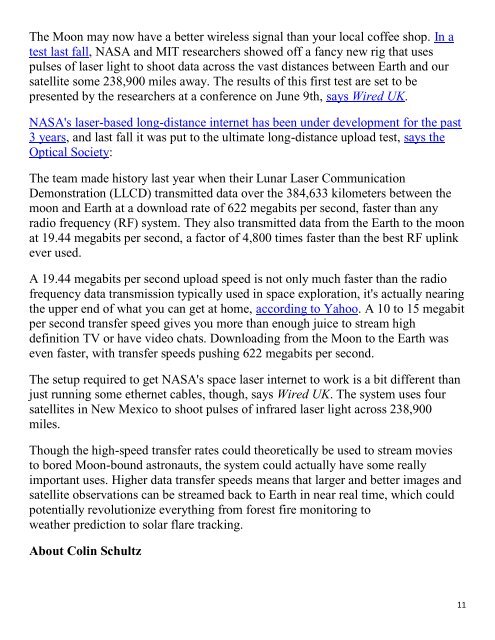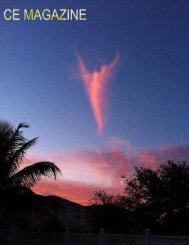Create successful ePaper yourself
Turn your PDF publications into a flip-book with our unique Google optimized e-Paper software.
The Moon may now have a better wireless signal than your local coffee shop. In a<br />
test last fall, NASA and MIT researchers showed off a fancy new rig that uses<br />
pulses of laser light to shoot data across the vast distan<strong>ce</strong>s between Earth and our<br />
satellite some 238,900 miles away. The results of this first test are set to be<br />
presented by the researchers at a conferen<strong>ce</strong> on June 9th, says Wired UK.<br />
NASA's laser-based long-distan<strong>ce</strong> internet has been under development for the past<br />
3 years, and last fall it was put to the ultimate long-distan<strong>ce</strong> upload test, says the<br />
Optical Society:<br />
The team made history last year when their Lunar Laser Communication<br />
Demonstration (LLCD) transmitted data over the 384,633 kilometers between the<br />
moon and Earth at a download rate of 622 megabits per second, faster than any<br />
radio frequency (RF) system. They also transmitted data from the Earth to the moon<br />
at 19.44 megabits per second, a factor of 4,800 times faster than the best RF uplink<br />
ever used.<br />
A 19.44 megabits per second upload speed is not only much faster than the radio<br />
frequency data transmission typically used in spa<strong>ce</strong> exploration, it's actually nearing<br />
the upper end of what you can get at home, according to Yahoo. A 10 to 15 megabit<br />
per second transfer speed gives you more than enough jui<strong>ce</strong> to stream high<br />
definition TV or have video chats. Downloading from the Moon to the Earth was<br />
even faster, with transfer speeds pushing 622 megabits per second.<br />
The setup required to get NASA's spa<strong>ce</strong> laser internet to work is a bit different than<br />
just running some ethernet cables, though, says Wired UK. The system uses four<br />
satellites in New Mexico to shoot pulses of infrared laser light across 238,900<br />
miles.<br />
Though the high-speed transfer rates could theoretically be used to stream movies<br />
to bored Moon-bound astronauts, the system could actually have some really<br />
important uses. Higher data transfer speeds means that larger and better images and<br />
satellite observations can be streamed back to Earth in near real time, which could<br />
potentially revolutionize everything from forest fire monitoring to<br />
weather prediction to solar flare tracking.<br />
About Colin Schultz<br />
11


















